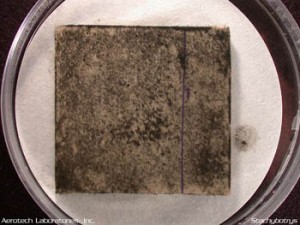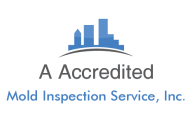Information from our toxic mold inspectors
Mold Biology And Toxic Mold Related Health Issues

Toxic mold growing on paper in a lab’s petri dish. This is typical of how Stachybotrys AKA toxic mold looks when growing on drywall or paper.
BASIC MOLD BIOLOGY:
During our investigations people often ask our toxic mold inspectors questions pertaining to fungal biology, toxins, and health. Well here are a few answers.
Fungi share some basic similarities with plants and bacteria but are not plants nor are they bacteria. They are in their own kingdom, the Fungi Kingdom.
The terms mold and mildew are often used interchangeably by lay persons, but according to some more specific definitions, mildew is a powdery growth that attacks and grows on living plants while molds are often fuzzy and grow on all sorts of moist surfaces. For some people the term mildew is used to describe powdery fungal growth that grows on personal belongings and can be easily wiped off. Molds, mildews, and other fungi usually reproduce by forming and releasing spores into the air. Most indoor spores are just 3 to 15 microns across, some spores are a few hundred microns long but these are still just a few microns across. The human eye can at best see objects that are 10 or more microns across. Toxins known as mycotoxins and also allergens are found primarily in the spores of various molds. These substances can be found in live or dead spores.
TOXIC MOLDS
Mycotoxins are chemicals that are sometimes produced by various species of toxic mold. These toxins are real and are powerful weapons used by toxic molds in a sort of microbial warfare to help them compete against bacteria and other molds. Various molds including but not limited to toxic black mold also known as Stachybotrys or toxic mold are common in Florida, but mold spores in residential settings, even if they are potentially toxic producing types and at high levels, are not automatically at high enough levels to result in toxic effects on humans via inhalation. It takes a lot of inhaled spores to poison a person. Currently, disagreement exists as to if residential mold spore exposures levels are ever high enough to result in toxic effect on humans. Toxic effects of mold mycotoxins in humans and farm animals leading to serious illness and even death via accidental ingestion of toxic mold, etc. have been well documented in scientific literature. Effects of heavy exposure to mold toxins are many, but just two of the more common effects are immuno suppression and liver cancer. Mycotoxins are believed to result in headaches, sore throats, hair loss, flu symptoms, diarrhea, fatigue, dermatitis, general malaise (tiredness) and psychological depression.” (Croft et al, 1986, Jarvis, 1995). “Other reported responses to mycotoxin exposure includes skin rashes, lesions of the skin and gastrointestinal tract, and interference with blood cell formation.” (Sorenson 1993).
Scientific studies have shown that even when toxic molds are present, the levels of toxins inhaled in a typical contaminated building are likely far too low to cause toxic reactions. Of course future studies may or may not change this current opinion held by many researches. Our toxic mold inspectors have not as of yet 2013 seen much proof of toxic reactions to mold, but people still get very sick when exposed to all types of mold.
Regardless of the presence or absence of any toxic effects of black mold it is common knowledge and widely accepted that upper respritory ailments such as allergies and asthma are common, such effects can be so sever that people believe they are experiencing toxic reactions.
INFECTIOUS MOLDS
According to a Mayo clinic study, sinusitis caused by growth of fungus fibers or balls of fungus fibers in the sinus cavities is not unusual. This is typically caused by common Aspergillus, Fusarium, and Curvularia species. Aspergillosis caused by the growth of Aspergillus species in the lungs most commonly A.fumigatus, A. flavus, A. Niger and A. territus species typically occurs in persons with compromised immune systems or a history of lung disease that resulted in past lung damage. Common Candida albicans that causes yeast infections is a major cause of serious nosocomial (hospital acquired) fungal infections. Histoplasma capsulatium and Cryptococcus neoformans are very dangerous yeast like molds that should be assumed to be present in any bird droppings but are primarily a concern when spread to humans via inhalation of particles from accumulations of pigeon, starling, and bat droppings. Coccidioides immitis mold spores are spread from dusty soil in the southwestern United States, it sometimes causes valley fever but at other times the same fungus can be deadly. Nearly any fungi can cause infections in persons with severely compromised immune systems.
Detection of infectious fungi such as but not limited to the above listed ones and identification of fungi to determine the species is not part of most mold inspections.
ALLERGY ASTHMA AND HYPERSENSITIVITY DISEASES
An allergic reaction occurs when your body’s immune system mistakes harmless proteins in mold spores or other allergens as if these proteins were harmful microbes trying to infect your body. Your body’s immune system, feeling threatened releases histamines into the blood stream and these histamines are what actually causes coughing, sneeze, and watering of the eyes. Other person’s immune systems will not mistake proteins in mold spores as a microbial threat, and thus not develop allergic reactions. Asthma is a condition where the small air sack like structures in the lungs called alveoli can contract and exhale air, but cannot properly expand to bring in new air. Molds as well as other substances are common triggers of asthma. Mold-related allergenic and asthmatic conditions in homes are very common and very serious and should be addressed and not ignored. Many serious hypersensitivity diseases in humans, such as baker’s lung, wood workers lung and others are the result of exposures to molds by persons working in industries that result in long term exposure to elevated spore levels.
Hypersensitivity diseases have long been well documented in science and the medical field. According to Bioaerosols assessment and control hypersensitivity pneumonitis is a hypersensitivity disease that results from the long term repeated exposure to elevated mold spore levels or other antigens, this condition can occur at in industry or agriculture where spore levels are high, it may also occur in moldy offices or homes, it produces pneumonia like symptoms with fever, cough, tightness of chest, lung infiltrates, and difficulty breathing. Once sensitized, individuals may react to extremely low, often un measurable, concentrations of antigenic materials.
Organic dust toxic syndrome is a flu like illness that results from a short term exposure to very high levels of spores, such as the levels that may be encountered by workers doing large mold remediation jobs without wearing protective respirators. Symptoms show up several hours or a day or so after exposure and symptoms go away after a day or a few days. Building related illness is a term used to describe an illness such as one of the above that results from time spent in a building around molds or other allergens, irritants, or toxins, and sick building syndrome is used to describe a building related illness whose specific cause remains a mystery.
If you fee you are in need of a professional and helpful toxic mold inspectors fell free to call us anytime.
